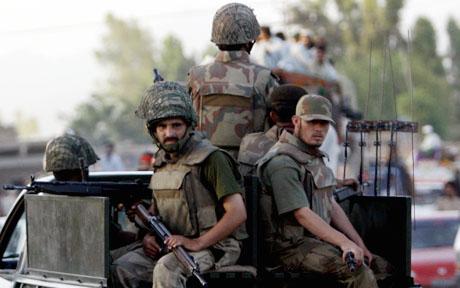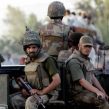
Pakistani Government Offensive in Swat Heading for the Taliban of Waziristan
Publication: Terrorism Monitor Volume: 7 Issue: 17
By:

After the Swat military offensive, Pakistan’s military has completed preparations for marching into Waziristan to fight a tough but decisive battle against the hardcore Taliban militia in the rugged mountains. The military offensive on this new front, dubbed “Operation Rah-e-Nijat” (Path of Salvation), is the extension and next phase of “Operation Rah-e-Rast” (Straight Path), regarded as Pakistan’s first major military operation since the War on Terrorism began. Huge losses were inflicted on Taliban militants during this operation. The Taliban are under immense pressure and their top leadership is on the run towards safer places. Some of them are believed to have moved into the bigger cities of Pakistan while the majority of them are penetrating deep into the South Waziristan tribal agency bordering Afghanistan. The government of Pakistan has vowed to chase the militants inside Waziristan, where Tehrik-e-Taliban Pakistan (TTP) chief Baitullah Mahsud has strong bases. Already the militants have reacted to the Swat offensive by bombing luxury hotels and targeting police and military convoys. Recently, Peshawar and other nearby cities have been their main target for terrorist attacks, but they are also active in far away cities like Lahore, where they killed senior cleric Mufti Sarfaraz Naeemi in a suicide blast for his anti-Taliban ideology. The Taliban are making last ditch efforts to unnerve the government through their attacks, but the Governor of the North-West Frontier Province (NWFP), Owais Ahmad Ghani has vowed to track the militants until their terrorist network is dismantled (Dawn [Karachi], June 15).
Battle for Waziristan
Pakistan’s army has formally announced the launching of its military operation into South Waziristan – the stronghold of Baitullah Mahsud and the TTP network. This is considered to be potentially the toughest battle Pakistan’s military has fought against the Taliban. All the pro-Taliban, banned jihadi outfits like Sipah-e-Sahaba, Jaish-e-Muhammad, Lashkar-e-Jhangvi and other militant organizations from South Punjab are expected to join this battle in the interests of their own survival. There are reports that Taliban militants from Swat, Bajaur, Mohmand, Kurram and Darra Adam Khel have entered into South Waziristan. Pakistan’s military spokesman Major General Athar Abbas has said they have carried out all the preparations and groundwork to challenge Baitullah’s 10,000-strong militia. The government has already moved heavy weaponry into areas adjoining Waziristan. Fearing a bloody battle between the military and Taliban in the area, families have started vacating the Mahsud region of the South Waziristan (Daily Times [Lahore], June 17; The News [Islamabad], June 11).
The targeted killings of religious clerics and suicide bombings in mosques and marketplaces have turned the popular tide against Baitullah Mahsud. There has been a significant shift in public opinion against him and his TTP network. Now even his one-time sympathizers want the elimination of his terror network.
Recently, there emerged a strong alliance against Baitullah, formed by Turkistan Bhittani and Qari Zainuddin Mahsud. The group has the tacit support of the government. Turkistan Bhittani and Qari Zainuddin have openly challenged Baitullah Mahsud, calling him an enemy of Islam and Pakistan. Speaking to local jirgas, they have vowed to take revenge against Baitullah for the killing of innocent Pakistani civilians and security forces (Khabrain [Lahore], June 14).
Turkistan Bhittani, 40, once a friend of Baitullah Mahsud who fought alongside the Taliban in Afghanistan, is now his biggest enemy. Turkistan also served in the Frontier Corps (FC) until his retirement in 1998. He developed differences with Baitullah and parted ways with him when Baitullah slaughtered some FC officials and began using suicide bombing as a tool to terrorize his opponents inside Pakistan.
Qari Zainuddin Mahsud, in his mid 20’s, leads the group formerly belonging to Abdullah Mahsud, a former detainee of Guantanamo who was killed by Pakistani military action in Baluchistan in July 2006. Belonging to the same tribe as Baitullah Mahsud, Qari Zainuddin poses a tough challenge for the TTP commander. The alliance of Turkistan and Qari Zainuddin has made it difficult for Baitullah to move around in the strategically important areas of Tank and Dera Ismail Khan (Dawn, June 16).
Even within the TTP, some rifts are expected to become more visible in the coming days. Mullah Nazir in South Waziristan and Haji Gul Bahadur in North Waziristan have shown some preference towards the government in the event of military operations in the area, declaring they do not wish to fight against Pakistani security forces.
All these developments indicate the isolation of Baitullah Mahsud. But he still enjoys the undisputed leadership of the TTP, which has a presence in all seven tribal agencies, along with some districts of the NWFP. He has a trained militia of over 10,000 men, including several hundred suicide bombers who have demonstrated their ability to strike anywhere in Pakistan.
Fallout of Military Operations
The apparent success of Operation Rah-i-Raast has come at a great cost. It has displaced over 2.5 million people from the war zones of the greater Swat Valley. Richard Holbrooke, President Obama’s Special Envoy to Pakistan and Afghanistan, admitted during his recent trip to Pakistani refugee camps that the issue of Internally Displaced Persons (IDPs) is a major crisis, describing it as the biggest mass exodus in Pakistan since its creation in 1947 (Daily Times [Lahore], June 11; Radio Buraq, June 4). The government was clearly not prepared to place and feed the IDP influx into Mardan, Swabi and other parts of the country.
The use of heavy artillery and aircraft against the militants in Swat was another factor that contributed to the misery of the people trapped in the valley, resulting in civilian casualties. Unable to counter the Army’s operations against the militants, the majority of the top TTP leadership escaped to the adjoining tribal areas and other safe hideouts in Malakand Division. Successful operations against the insurgents have been conducted through surgical strikes involving Special Commando Forces and local police (The News, May 28). It is believed that the majority of militants from the Swat Valley have left for South Waziristan, where they are planning to strike back against the government and other anti-Taliban elements. The recent suicide bombing at Peshawar’s only five-star hotel, the Pearl Continental, was a message from the Taliban to the opposition in response to ongoing military operations. The hotel is significant for its use by foreign dignitaries, including the officials of relief agencies dealing with the IDPs, and is located close to the provincial parliament, the High Court and residences of the Governor, Chief Minister and Corps Commander (provincial military chief). This attack was soon followed by other suicide attacks on police officials and mosques in various parts of the NWFP, including those in Nowshera and Dera Ismail Khan. However, it was the June 12 killing of Mufti Sarfaraz Naeemi in Lahore by the Taliban that provoked countrywide condemnation and violent protests against the TTP. Mufti Naeemi, 61, was a respected Sunni-Barelvi cleric who had spoken out against the Taliban and declared suicide bombing un-Islamic (Dawn, June 14). Despite this, the Taliban have issued warnings they will kill more high profile clerics in Pakistan (Daily Times, June 17).
The IDP Crisis
The lack of sufficient funds, infrastructure, and services has disappointed the majority of the IDPs in tented camps. About 90 percent of these IDPs prefer to live in school buildings, mosques and with host-families where the relief agencies find it difficult to track them down for the proper distribution of aid and services. The government has not yet chalked out any short or long-term policies for the placement and rehabilitation of the massive influx of refugees from Malakand Division and those now arriving from South Waziristan as well. The majority of the IDPs from Waziristan prefer to go to Karachi instead of Peshawar. The reason is that Mahsud and Wazir have businesses and family relations in Karachi. However, the Muttahida Qaumi Movement (MQM) has already protested against the settlement of these IDPs in Karachi, saying this will spread Talibanization in Karachi (The News, May 28).
In the face of these crises, the IDPs have suffered most from the ongoing military operation. However, so far they have supported the government in its offensive. The lack of assistance from the government and aid agencies and the spoiling of ready-to-harvest crops back home have created an urgency in the IDPs to return home as soon as possible. In Dhog Darra of Dir district in Malakand, some 2,500 villagers who do not want to become IDPs have raised armed lashkars (ad-hoc militias) against the Taliban and have successfully flushed the TTP from some villages with initial support from the military. Now the lashkars need more military support to completely eliminate the militants’ network from the area, but they complain of not getting backup from the military (Dawn, June 17).
Conclusion
In the Swat military offensive, the government claimed to have killed more than 1,400 militants, among them the Taliban’s second and third-tier leadership. However the fact is that the top Taliban leadership is still at large, which is worrisome for the IDPs who fled the region. They fear the Taliban’s comeback if they are not brought to justice.
The extensive and ongoing military operation against the Taliban cannot be fully successful unless there are proper arrangements for the IDPs. If the IDPs lose hope in the government, their makeshift camps can turn into breeding grounds for Talibanization. At the same time, these IDPs are a great opportunity for both Pakistan and the United States. In this hour of misery and need, their hearts and minds can be won by only a small effort to feed, place and rehabilitate them. They need to be visited and be listened to in their camps by dignitaries, as in the example set by former Pakistani Prime Minister Nawaz Sharif and President Obama’s Special Envoy to Pakistan-Afghanistan, Richard Holbrooke. This is the first time during the last eight years that a significant majority of Pakistanis are standing together against the militants. If this opportunity is lost, another one may not be available in the near future.





